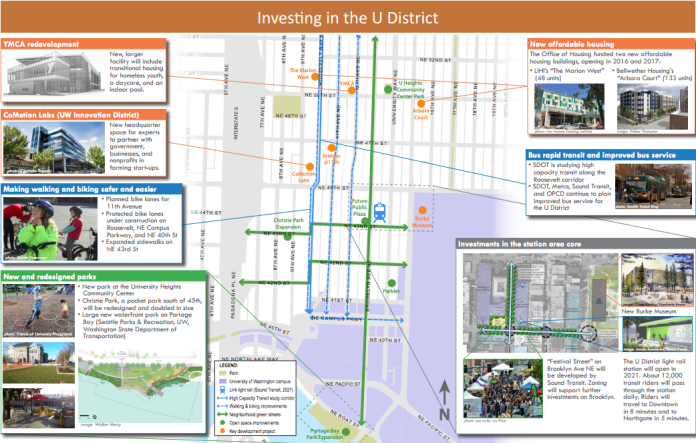The University District is increasingly becoming a beneficiary of significant public and non-profit investments. In releasing the updated neighborhood rezone and urban design proposal two weeks ago, the Office of Planning and Community Development published an appendix to highlight neighborhood investment commitments. At the top of the list are:
- A new light rail station at NE 43rd St and Brooklyn Ave NE (opening 2021);
- Enhanced bus service on the Roosevelt and 12th Avenue couplet (opening 2021 or sooner);
- New Portage Bay Park (opening 2018) and University of Washington plaza;
- New NE 43rd St Green Street;
- Protected bike lanes on NE Campus Pkwy (opened 2015), Roosevelt Way NE (opened 2015, completed fall 2016) , and NE 40th St (opened 2015);
- 181 new affordable housing units (opening 2016 and 2017); and
- New Burke Museum (opening fall 2019).
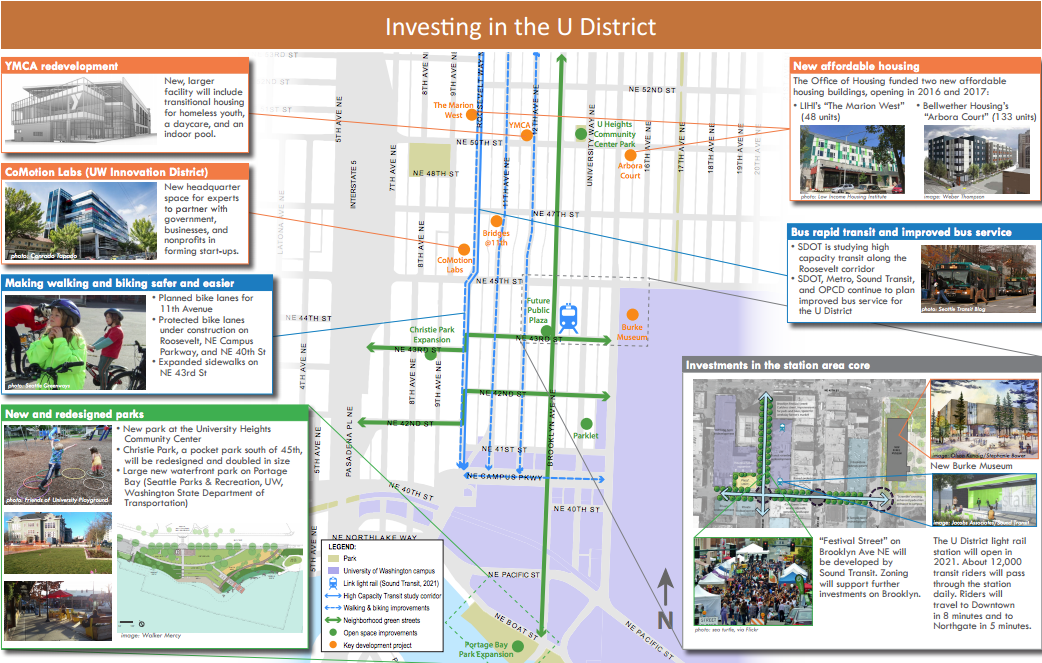
Affordable Housing and Social Services
Earlier this year, a project sponsored by LIHI called “The Marion West” opened as a mixed-use development to provide space for 48 apartments geared toward low-income and homeless youth, and dedicating ground floor space to the University District Food Bank. Later next year, Bellwether Housing will open “Arbora Court” as affordable housing serving 133 low-income households. The YMCA is also actively considering redeveloped of property on NE 50th St. New space for a daycare, indoor pool, and transitional housing for homeless youth would be included in the major renovation project.
The University District is fortunate to have other committed organizations partnering to deliver opportunities for homeless youth like ROOTS, a shelter for young adults. ROOTS has created a successful initiative that pairs sheltered youth with job training and employment opportunities. The U District Partnership began collaborating with ROOTS on the program in 2014 and has sought additional partnerships with University of Washington and City of Seattle to expand the initiative. Sources say that the Mayor’s Office intends to directly support the initiative through City resources.
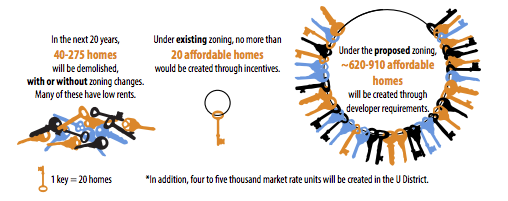
OPCD’s zoning proposal would build upon these social welfare commitments by requiring new developments to participate in the City’s Mandatory Housing Affordability (MHA) program and offering incentives for human services uses. At least 620 new affordable housing units could be built under the MHA program over the next 20 years. But an even higher 910 affordable homes could be created if all goes well. Juxtapose that to what would otherwise happen if no changes are made: only 20 affordable housing units would be delivered through existing development incentives. The zoning proposal further gives developers incentives in SM-U zones (the densest zones proposed near the neighborhood core) to build space human services uses like mental health care, alcohol or drug abuse services, and daycare service for adults. The incentive would allow developers to build beyond the base floor area ratio maximum.
Transportation
Sound Transit is earnestly building a new light rail station in the University District that will open as part of the Northgate Extension. On the corner of NE 43rd St and Brooklyn Ave NE, the station site is situated at the heart of the neighborhood on a large parcel of land. The station will serve a dense and growing neighborhood dependent upon transit, due in part to the substantial number of college students and the University of Washington campus. Sound Transit plans to open the station in 2021, which is partially why the City is considering zoning and urban design changes to the neighborhood.
Complimenting this light rail investment is a commitment to a new enhanced bus service that would run at least from Downtown to Roosevelt along the Roosevelt Way NE and 12th Ave NE couplet in the University District. This service would essentially be a shadow route of Link, filling in the transit gaps between the station anchors of Westlake and Roosevelt. The bus line could eventually be extended all the way to Northgate in a future phase. Not noted in the map are further upgrades to Metro’s Route 44 bus line that could get similar enhancements and continue toward Children’s Hospital.
In recent years, the Seattle Department of Transportation (SDOT) has improved pedestrian and bicycle connections. The last big foray into investments was this summer when the agency upgraded protected bike lanes on Roosevelt Way NE and added brand new pedestrian crossings, transit islands, and curb extensions. New protected bike lanes were deployed last year on portions of NE 40th St, Brooklyn Ave NE, and NE Campus Pkwy to improve connections and tighten up the streets.
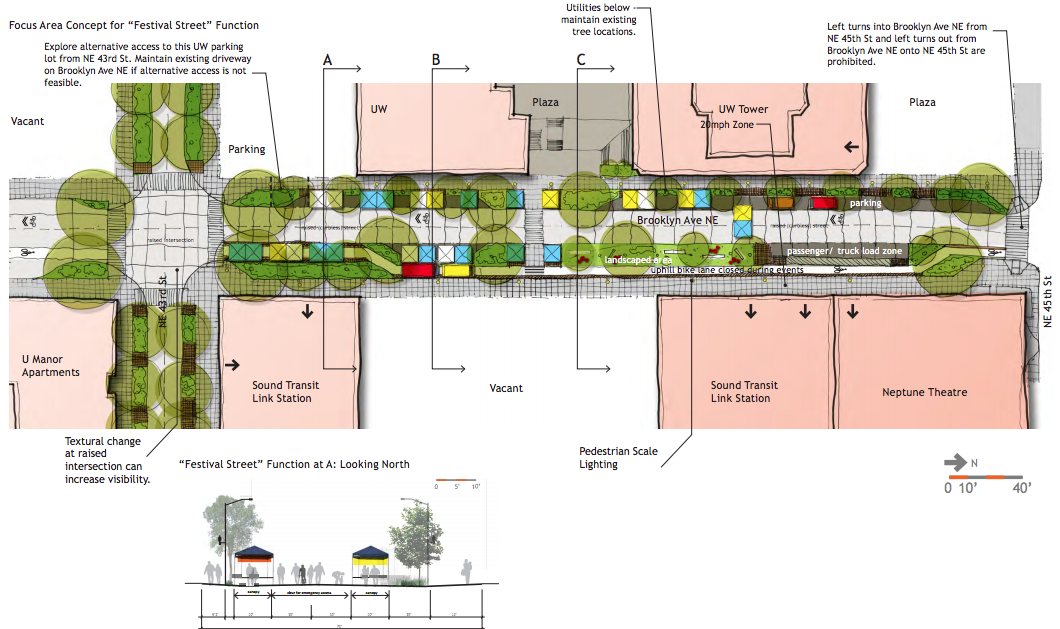
SDOT has developed a series of Green Street concepts for the University District. New developments will carry most of the load in building calmer streets with landscaping, wider sidewalks, extra plaza spaces, and street furniture. SDOT has committed to making some early investments on perhaps the most important stretch of road in the Green Streets concept plans. SDOT will bring NE 43rd St, from 15th Ave NE to the alley between Brooklyn Ave NE and University Way NE, up the specified Green Street standards. The improvements will match those that Sound Transit will deliver as part of the light rail station construction, which include a “festival street” on Brooklyn Ave NE. SDOT will build out the much-needed wider and greener streets from the university campus and light rail station site before the station opens in 2021.
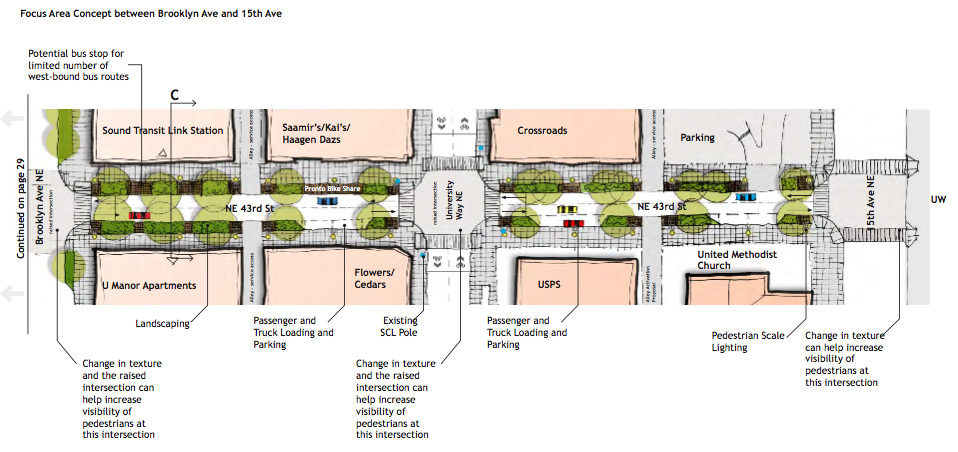
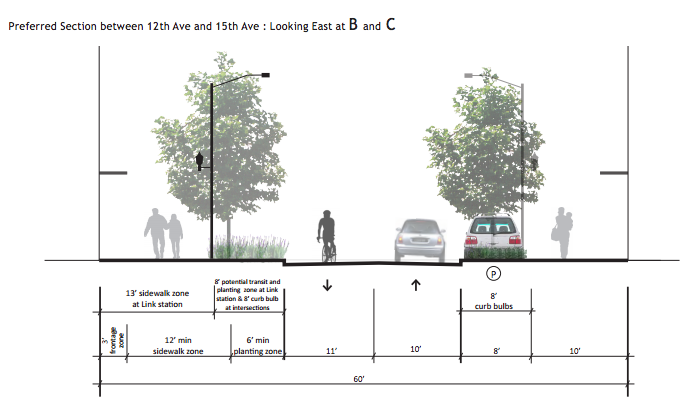
Public Space
Residents and community advocates of the University District have been mindful of the need for more public open space throughout the neighborhood. Many have said that spaces like the University Playground and small pocket parks (e.g., University Heights Community Center, Sakuma Viewpoint, and Christie Park) aren’t enough. Others have argued the University of Washington offers vast amounts open green spaces. But, in response, some contend the university can expel the public from campus grounds and that physical barriers along 15th Ave NE act as a deterrent.
One of the leading neighborhood advocacy groups, U District Square, has sought a central plaza space in the heart of the district for years. In 2014, the community engaged in a stakeholder driven process to discuss open space needs, which ranged from streetscape improvements to University Way (The Ave), creating pocket parks throughout the district to constructing a large plaza on or near the light rail station to closing The Ave and turning it into a pedestrian mall to using existing neighborhood right-of-way as an extended “living room” by greening them up.
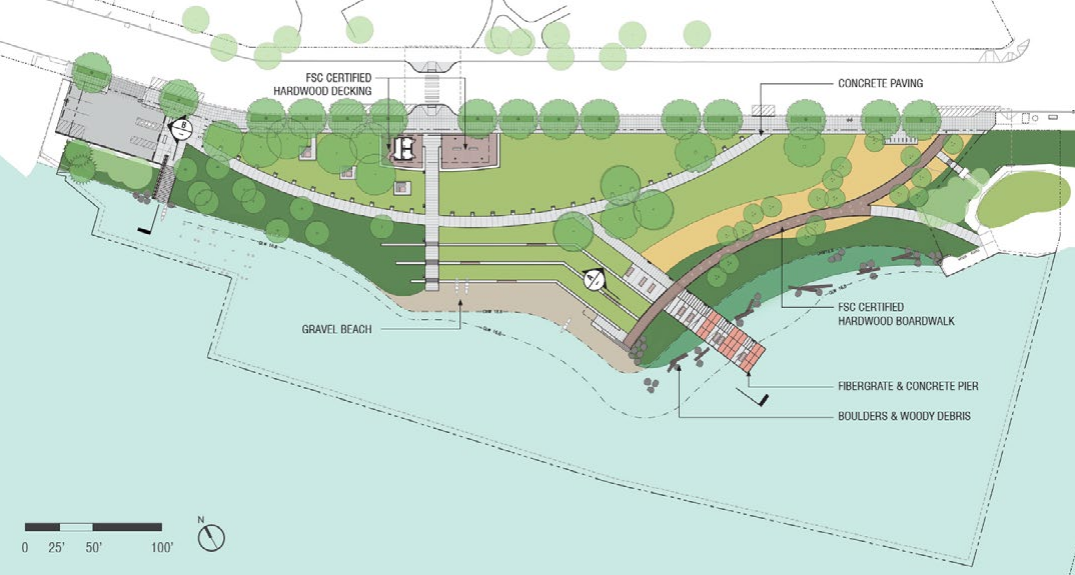
Seattle Parks and Recreation (SPR) has committed to building two new park spaces and has already delivered another. SPR will expand the existing Christie Park space by adding an extra lot to the site. A larger project is already underway for a new Portage Bay Park, which will connect Sakuma Viewpoint off of NE Boat St and open in 2018. Last year, SPR wrapped up construction of a new park space on the south parking lot at University Heights Center.
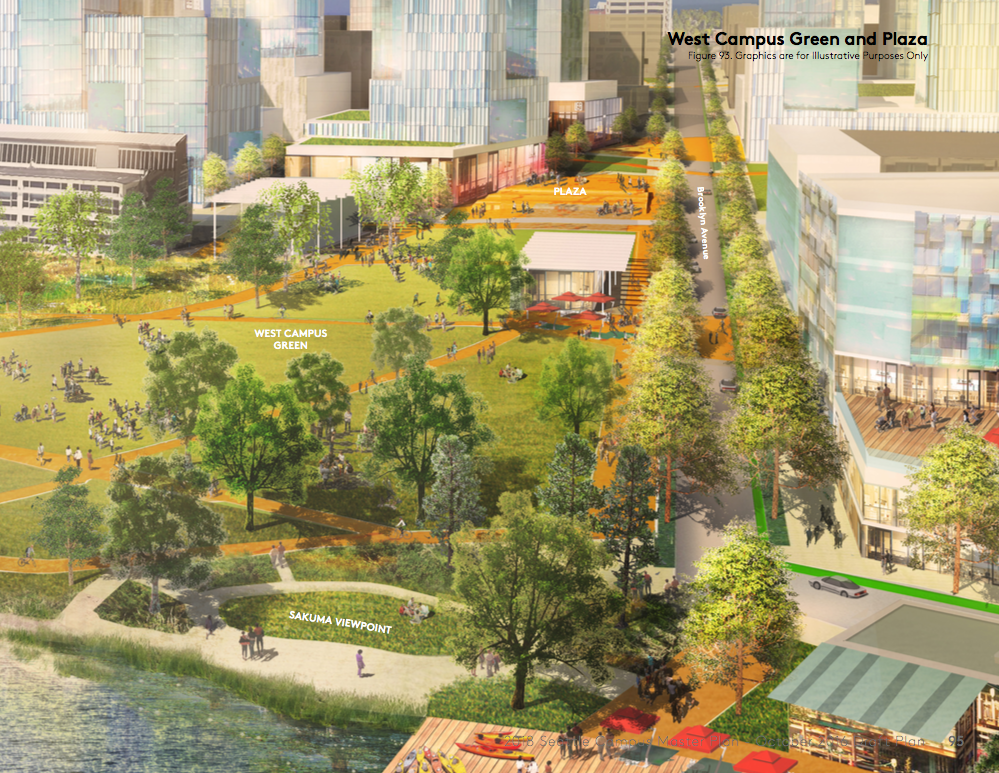
The University of Washington has also said that the University of Washington Tower site could be redeveloped in the coming years, allowing for a new plaza space on the block’s southeast corner. It isn’t the site that many open space advocates had hoped for at the light rail station site, but it would offer a nearby space for the community to use. The plaza space is contingent on the university being allowed to build a tower above the University District light rail station.
The university also envisions additional open space in the heart of the neighborhood. As we detailed last week, the University of Washington is seeking public review of their draft 2018 campus masterplan, which could deliver a massive West Campus Green and Plaza (a total of 4.56 acres) connecting Sakuma Viewpoint and Portage Bay Park to the lower end of the burgeoning West Campus. New green streets could also further enhance the earthy, green feel of that reach of the district.
In addition to all of this, the University District Green Street concept plans would be realized by new development, as discussed above.
Other Investments
OPCD highlights many other significant investments like staff housing for the university and Children’s Hospital, childcare facilities, public safety coordination, and sanitation and curb appeal.
Staff housing:
The recent successful collaboration between UW and Children’s Hospital on the “Bridges@11th” project provided 184 apartments, 37 of which are affordable to households earning 65%-85% of area median income. Many are larger, family-friendly units. The UW is continuing to look for ways to expand faculty and staff housing opportunities near campus.
Childcare:
The UW is expanding its childcare program by approximately 140 spaces to help meet the needs of faculty, staff and students. There are currently three child care centers at the Seattle campus providing year-round, on-site infant, toddler, and preschool childcare.
Public safety:
The Seattle Police Department (SPD) designated a Community Police Team officer to the U District who works with community members to promote public safety. The UW Police Department (UWPD) works in partnership with SPD and serves as backup. The UWPD recently moved to a new building on 15th Ave NE and will share the space with SPD. Partnerships with the City of Seattle and University Police departments allow the UDP to track crime in the U District resulting in an improved public perception of safety. Coordination between UWPD, SPD, and King County Metro Police has substantially reduced drug dealing on the Ave.
Sanitation and curb appeal:
The “Clean and Safe” initiative has been identified as the highest priority for the UDP. The UDP promotes use of the City’s “Find it, Fix It” app, monitors coordinated cleaning efforts, and addresses vacant properties. UDP staff and volunteers provide ongoing street cleaning, pressure washing, and graffiti removal, and organize monthly cleanups around the U District with 25-50 volunteers at each event. The Clean and Safe Committee recently completed the “U Loo” study, in partnership with the U District Conversation on Homelessness and DON. The study recommends the installation of 24/7 public restroom facilities in the U District.
What’s Next
The proposal will go to the the City Council’s Planning, Land Use, and Zoning (PLUZ) Committee this month. On November 16th, a public hearing (6.15pm) on the legislation will be held at Hotel Deca in the University District. Preceding the public hearing will be an open house (5.30pm) and presentation (6pm) on the proposal. The PLUZ Committee will also carry out further review and deliberation on the proposal at additional meetings toward the end of the year.
For more on the University District rezone and urban design proposals, see our previous coverage:
- University District Draft Rezone Recommendations Released
- University District Rezone Proposal: A Deeper Look At Urban Design Requirements
- University District Rezone Proposal: A Deeper Look At Incentive Zoning, Historic Preservation, And Affordable Housing
- University District Rezone And Urban Design Proposal Sees Alterations
Seattle OPCD – U District Appendix D by The Urbanist on Scribd
Stephen is a professional urban planner in Puget Sound with a passion for sustainable, livable, and diverse cities. He is especially interested in how policies, regulations, and programs can promote positive outcomes for communities. With stints in great cities like Bellingham and Cork, Stephen currently lives in Seattle. He primarily covers land use and transportation issues and has been with The Urbanist since 2014.


